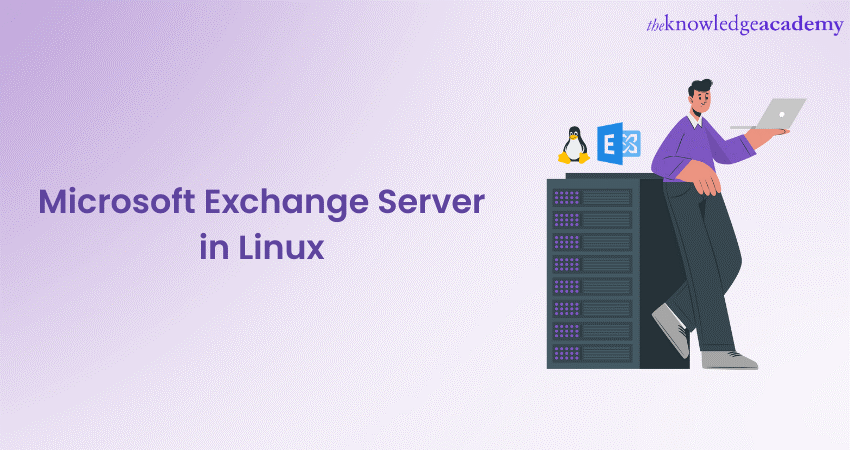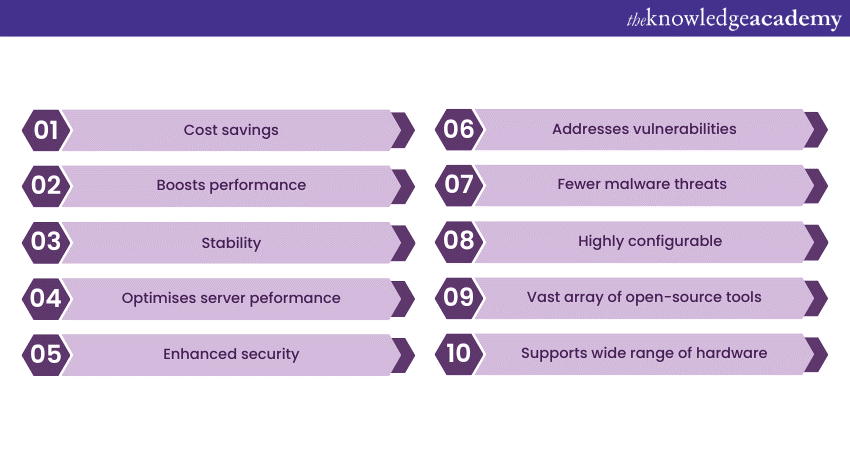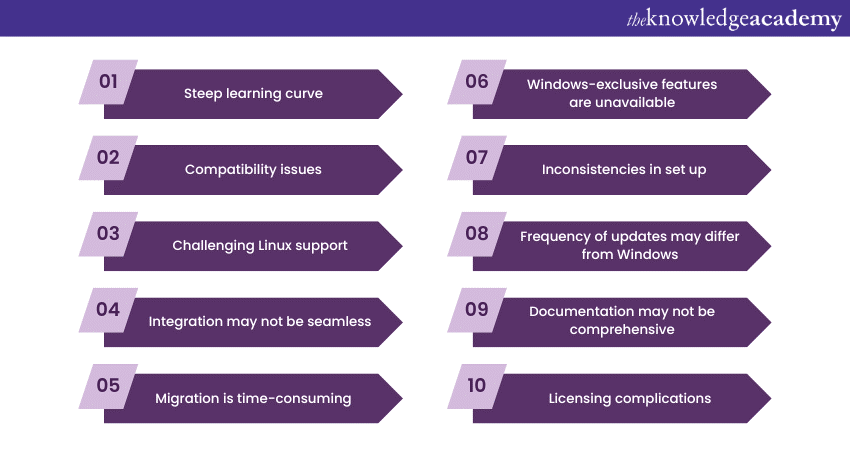We may not have the course you’re looking for. If you enquire or give us a call on 01344203999 and speak to our training experts, we may still be able to help with your training requirements.
Training Outcomes Within Your Budget!
We ensure quality, budget-alignment, and timely delivery by our expert instructors.

In the evolving IT landscape, many organisations are exploring the potential of running Microsoft Exchange Server on Linux. The integration of Exchange Server in Linux – though beneficial – is a process that needs to be understood, and its limitations must be considered before implementing it. In this blog, we will dive into the process of implementing Microsoft Exchange Server in Linux, as well as its benefits and limitations.
Table of Contents
1) How to set up Microsoft Exchange Server in Linux?
a) Prerequisites
b) Installation
c) Configuration
d) Integration
e) Management and maintenance
2) Benefits of running Exchange Server in Linux
3) Limitations of running Exchange Server in Linux
4) Conclusion
How to set up Microsoft Exchange Server in Linux?
This section of the blog will tell you all you need to know about how to set up Microsoft Exchange Server in Linux.
Prerequisites
The following are the prerequisites to set up Microsoft Exchange Server in Linux.
1) Linux distribution: First, choose a Linux distribution that is known to be compatible and stable for running server-side applications, such as CentOS, Ubuntu Server, or Red Hat Enterprise Linux.
2) Hardware requirements: Ensure that the server meets the minimum hardware requirements for Exchange Server. This generally includes an appropriate amount of CPU cores, RAM, storage, and network capabilities.
3) System updates: Ensure that your Linux system is updated with the newest patches and updates.
4) Dependencies: Identify and install any necessary software dependencies that Exchange Server might require in a Linux environment.
Installation
You need to adhere to the following aspects to install Microsoft Exchange Server Linux.
1) Microsoft repository: Depending on the Linux distribution, you might need to add Microsoft's official repository for Exchange Server to your package manager.
2) Download packages: Use the package manager (e.g., apt for Ubuntu or yum for CentOS) to download the Exchange Server packages.
3) Install: Execute the installation commands. This might vary depending on the distribution, but for instance:
sudo apt install exchange-server
4) Verification: Post-installation, you should verify the install by checking the version or starting the Exchange service to ensure it's operational.
Unlock the full potential of Exchange Server by joining our comprehensive Administering Microsoft Exchange Server 2016/2019 M20345-1 Course today!
Configuration
Follow these steps to ensure proper configuration of your Exchange Server.
1) Initial configuration: Start the Exchange setup wizard (if available) or use command-line tools to configure Exchange Server settings such as domain, database location, and more.
2) Mailbox databases: Set up and configure mailbox databases, ensuring that storage paths and backup configurations are in place.
3) Roles and services: Depending on your organisation's needs, you'll want to set up roles like Mailbox Server or Edge Transport Server.
4) Firewall and ports: Make sure that necessary ports are open and appropriately secured in your firewall settings to allow for mail flow and client access.
5) SSL certificates: For secure communication, you'll need to set up and install SSL certificates for the Exchange services.
Integration
Consider these aspects to guarantee seamless integration of Exchange Server.
1) Active directory: If you have an Active Directory (AD) setup, you would need tools like Samba to connect the Linux server to the AD domain and ensure Exchange Server integrates with it.
2) Email clients: Ensure compatibility and smooth integration with popular email clients, be it Microsoft Outlook, Thunderbird, or others.
3) Third-party services and plugins: If you're utilising any third-party tools, plugins, or services with Exchange Server, ensure they're compatible and integrated smoothly with your Linux setup.
Management and maintenance
Consider these aspects to ensure proper management and maintenance of Exchange Server.
1) Monitoring: Set up monitoring tools to keep an eye on the Exchange Server's health, performance, and security. Tools like Nagios or Zabbix can be invaluable in a Linux environment.
2) Backup and recovery: Ensure you have a reliable backup system in place. Regularly test recovery processes to ensure data integrity and availability.
3) Updates: Regularly check for updates for both the Exchange Server and the underlying Linux system. This is crucial for security and performance.
4) Logging and reporting: Configure detailed logging for the Exchange Server and regularly review logs to identify any potential issues or malicious activity.
Unlock the full potential of Microsoft Exchange with our expert-led Microsoft Exchange Server Training!
Benefits of running Exchange Server in Linux
The following are some of the benefits of running Exchange Server in Linux.

1) Cost savings: Many Linux distributions offer no licensing fees, leading to cost savings.
2) Boosts performance: Linux's efficient hardware utilisation boosts performance.
3) Stability: Linux servers provide notable stability, especially under high demand.
4) Optimises server peformance: Detailed resource management in Linux optimises server performance.
5) Enhances security: Built-in security features like SELinux enhance system protection.
6) Addresses vulnerabilities: The Linux community quickly addresses and patches vulnerabilities.
7) Fewer malware threats: Linux faces fewer malware threats compared to Windows systems.
8) Highly configurable: The Linux platform is highly configurable to fit specific needs.
9) Vast array of open-source tools: A vast array of open-source tools are available within the Linux ecosystem.
10) Supports wide range of hardware: Linux supports a wide variety of hardware, offering infrastructure flexibility.
Limitations of running Exchange Server in Linux
The following are some of the limitations of running Exchange Server in Linux.

1) Steep learning curve: There's a steep learning curve for teams accustomed to Windows environments.
2) Compatibility issues: Compatibility issues may arise with plugins or extensions designed for Windows.
3) Challenging Linux support: Potential challenges in obtaining expert-level support specific to Linux.
4) Integration may not be seamless: Integration with other Microsoft products might not be as seamless.
5) Migration is time-consuming: Migration from a Windows server to Linux can be complex and time-consuming.
6) Windows-exclusive features are unavailable: Some features or tools exclusive to Windows might be unavailable on Linux.
7) Inconsistencies in setup: Linux's diverse range of distributions may lead to inconsistencies in setup or performance.
8) Frequency of updates may differ from Windows: The frequency and method of updates might differ from traditional Windows setups.
9) Documentation may not be comprehensive: Documentation for running Exchange on Linux may not be as comprehensive.
10) Licensing complications: Potential licensing complications when integrating proprietary software.
Conclusion
The era where Microsoft and Linux were viewed as two distinct, non-overlapping softwares is fading. With Microsoft Exchange Server in Linux being an option that many organisations are choosing, the bridges between these two worlds are becoming more robust. For businesses, this means more choices, better cost efficiency, and the ability to tailor infrastructure to exact needs.
Unlock expert skills in Exchange Server: Join our Designing And Deploying Microsoft Exchange Server 2016/2019 M20345-2 Course today!
Frequently Asked Questions
Upcoming IT Infrastructure & Networking Resources Batches & Dates
Date
 Administering Microsoft Exchange Server 2016/2019 M20345-1
Administering Microsoft Exchange Server 2016/2019 M20345-1
Mon 29th Jul 2024
Mon 16th Dec 2024







 Top Rated Course
Top Rated Course



 If you wish to make any changes to your course, please
If you wish to make any changes to your course, please


